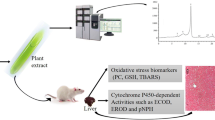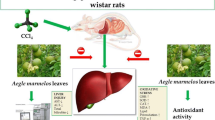Abstract
Effect of isolated astaxanthin (ASX) and astaxanthin esters (ASXEs) from green microalga-Haematococcus pluvialis on hepatotoxicity and antioxidant activity against carbon tetrachloride (CCl4) induced toxicity in rats was compared with synthetic astaxanthin (SASX). ASX, ASXEs, and SASX, all dissolved in olive oil, fed to rats with 100 and 250 μg/kg b.w for 14 days. They were evaluated for their hepatoprotective and antioxidant activity by measuring appropriate enzymes. Among the treated groups, the SGPT, SGOT and ALP levels were decreased by 2, 2.4, and 1.5 fold in ASXEs treated group at 250 μg/Kg b.w. when compared to toxin group. Further, antioxidant enzymes catalase, glutathione, superoxide dismutase and lipid peroxidase levels were estimated in treated groups, their levels were reduced by 30–50 % in the toxin group, however these levels restored by 136.95 and 238.48 % in ASXEs treated group at 250 μg/kg. The lipid peroxidation was restored by 5.2 and 2.8 fold in ASXEs and ASX treated groups at 250 μg/kg. The total protein, albumin and bilirubin contents were decreased in toxin group, whereas normalized in ASXEs treated group. These results indicates that ASX and ASXEs have better hepatoprotection and antioxidant activity, therefore can be used in pharmaceutical and nutraceutical applications and also extended to use as food colorant.




Similar content being viewed by others
References
Aebi H (1984) Catalase in vitro methods of assays. Methods Enzymol 105:121–126
Bergmeyer HU, Horder M (1980) International federation of clinical chemistry methods for the measurement of catalytic concentrations of enzymes. Clin Chem Acta 105:147–172
Bergmeyer HU, Bowers JR, Hörder M, Moss DW (1976) Provisional recommendations on IFCC Methods for the measurement of catalytic concentrations of enzymes. Part 2. IFCC method for aspartat aminotransferase. Clin Chim Acta 70:19–42
Buege JA, Aust SD (1978) Microsomal lipid peroxidation. Methods Enzymol 52:302–310
Chatterjee M, Roy K, Janarthan M, Das S, Chatterjee M (2012) Biological activity of carotenoids: its implications in cancer risk and prevention. Curr Pharm Biotechnol 13:180–190
Chidambara Murthy KN, Rajesha J, Vanitha A, Swamy MM, Ravishankar GA (2005a) Protective effect of Dunaliella salina- A marine micro alga, against carbon tetrachloride hepatotoxicity in rats. Hepatol Res 33:313–319
Chidambara Murthy KN, Rajesha J, Swamy MM, Ravishankar GA (2005b) Comparative evaluation of hepatoprotective activity of carotenoids of microalgae. J Med Food 8:523–528
Fassett RG, Combes JS (2011) Astaxanthin: a potential therapeutic agent in cardiovascular disease. Mar Drugs 9:447–465
Flohe L, Otting F (1984) Superoxide dismutase assays. Methods Enzymol 105:93–104
González-Burgos E, Gómez-Serranillos MP (2012) Terpene compounds in nature: a review of their potential antioxidant activity. Curr Med Chem 19:5319–5341
Hussein G, Goto H, Oda S, Sankawa U, Matsumoto K, Watanabe H (2006) Antihypertensive potential and mechanism of action of astaxanthin: III. Antioxidant and histopathological effects in spontaneously hypertensive rats. Biol Pharm Bull 29:684–688
Jaeschke H, McGill MR, Ramachandran A (2012) Oxidant stress, mitochondria, and cell death mechanisms in drug-induced liver injury: lessons learned from acetaminophen hepatotoxicity. Drug Metab Rev 44:88–106
Kadiiska MB, Gladena BC, Bairda DD, Germoleca D (2005) Biomarkers of oxidative stress study II. Are oxidation products of lipids, proteins and DNA markers of CCl4 poisoning? Free Radic Biol Med 38:698–710
Kamath BS, Srikanta BM, Dharmesh SM, Sarada R, Ravishankar GA (2008) Ulcer preventive and antioxidative properties of astaxanthin from Haematococcus pluvialis. Eur J Pharmacol 590:387–395
Kang JO, Kim SJ, Kim H (2001) Effect of astaxanthin on the hepatotoxicity, lipid peroxidation and antioxidative enzymes in the liver of CCl4-treated rats. Methods Find Exp Clin Pharmacol 23:79–84
Lee R, Margaritis M, Channon KM, Antoniades C (2012) Evaluating oxidative stress in human cardiovascular disease: methodological aspects and considerations. Curr Med Chem 19:2504–2520
Lorenz RT, Cysewski GR (2000) Commercial potential for Haematococcus microalgae as a natural source of astaxanthin. Trends Biotechnol 18:160–167
Lowry OH, Rosebrough NJ, Farr AL, Randall JL (1951) Protein measurement with Folin-phenol reagent. J Biol Chem 193:265–275
Malloy HT, Evelyn KA (1937) The determination of bilirubin by photoelectric colorimeter. J Biol Chem 119:481–487
Maoka T, Tokuda H, Suzuki N, Kato H, Etoh H (2012) Anti-oxidative, anti-tumor-promoting, and anti-carcinogensis activities of nitro astaxanthin and nitrolutein, the reaction products of astaxanthin and lutein with peroxynitrite. Mar Drugs 10:1391–1399
Negre‐Salvayre A, Coatrieux C, Ingueneau C, Salvayre R (2008) Advanced lipid peroxidation end products in oxidative damage to proteins. Potential role in diseases and therapeutic prospects for the inhibitors. Br J Pharmacol 153:6–20
Park JS, Jong HC, Yoo KK, Larry LL, Boon PC (2010) Astaxanthin decreased oxidative stress and inflammation and enhanced immune response in humans. Nutr Metab 7:18
Ranga Rao A, Sarada R, Baskaran V, Ravishankar GA (2006) Antioxidant activity of Botryococcus braunii extract elucidated in vitro models. J Agric Food Chem 54:4593–4599
Ranga Rao A, Sarada, Baskaran V, Ravishankar GA (2009) Identification of carotenoids from green alga Haematococcus pluvialis by HPLC and LC-MS (APCI) and their antioxidant properties. J Microbiol Biotechnol 19:1333–1341
Ranga Rao A, Raghunath Reddy RL, Baskaran V, Sarada R, Ravishankar GA (2010) Characterization of microalgal carotenoids by mass spectrometry and their bioavailability and antioxidant properties elucidated in rat model. J Agric Food Chem 58:8553–8559
Ranga Rao A, Baskaran V, Sarada R, Ravishankar GA (2013a) In vivo bioavailability and antioxidant activity of carotenoids from microalgal biomass—a repeated dose study. Food Res Int 54:711–717
Ranga Rao A, Sindhuja HN, Dharmesh SM, Sankar KU, Sarada R, Ravishankar GA (2013b) Effective inhibition of skin cancer, tyrosinase, and antioxidative properties by astaxanthin and astaxanthin esters from the green alga Haematococcus pluvialis. J Agric Food Chem 61:384–3851
Ranga Rao A, Phang SM, Sarada R, Ravishankar GA (2014) Astaxanthin: sources, extraction, stability, biological activities and its commercial applications—a review. Mar Drugs 12:128–152
Sanda A, Gal A, Pintea A, Bedecean I, Arion A, Baba AI (2008) Influence of astaxanthin administration on hepatic oxidative stress markers in rats injected with methylnitrosurea. Bull UASVM Vet Med 65(1):pISS 1843–pISS 5270
Sarada R, Usha T, Ravishankar GA (2002) Influence of stress on astaxanthin production in Haematococcus pluvialis grown under different culture conditions. Process Biochem 37:623–627
Sindhu ER, Firdous AP, Preethi KC, Kuttan R (2010) Carotenoid lutein protects rats from paracetamol-, carbon tetrachloride- and ethanol-induced hepatic damage. J Pharm Pharmacol 62:1054–1060
Szasz G, Weimann G, Stahler F, Wahlefeld AW, Persijn JP (1974) New substrates for measuring gamma glutamyl transpeptidase activity. Z Klin Chem Klin Biochem 12:228
Takaichi S (2011) Carotenoids in algae: distributions, biosynthesis and functions. Mar Drugs 9:1101–1118
Turkez H, Geyikoglu F, Yousef MI (2012) Beneficial effect of astaxanthin on 2, 3, 7, 8-tetrachlorodibenzo-p-dioxin-induced liver injury in rats. Toxicol Ind Health 29:591–599
Uttara B, Singh AV, Zamboni P, Mahajan RT (2009) Oxidative stress and neurodegenerative diseases: a review of upstream and downstream antioxidant therapeutic options. Curr Neuropharmacol 7:65–74
Vanitha A, Chidambara Murhty KN, Kumar V, Sakthivelu G, Veigas JM, Saibaba P, Ravishankar GA (2007) Effect of the carotenoid producing alga, Dunaliella bardawil, on CCl4 induced toxicity in rats. Int J Toxicol 26:159–167
Wang J, Han D, Sommerfeld MR, Lu C, Hu Q (2013) Effect of initial biomass density on growth and astaxanthin production of Haematococcus pluvialis in an outdoor photobioreactor. J Appl Phycol 25:253–260
Wooton IDP (1964) Microanalysis in medical biochemistry, 4th edn. J. and A. Churchill Ltd, London, pp 138–140
Yeum KJ, Russell RM (2002) Carotenoid bioavailability and bioconversion. Annu Rev Nutr 22:483–504
Yuan JP, Peng J, Yin K, Wang JH (2011) Potential health-promoting effects of astaxanthin: a high-value carotenoid mostly from microalgae. Mol Nutr Food Res 55:150–165
Acknowledgments
The award of Senior Research Fellowship to ARR by the Indian Council of Medical Research (ICMR), New Delhi, is gratefully acknowledged.
Conflict of interest
The authors declare that they have no conflict of interest.
Author information
Authors and Affiliations
Corresponding author
Rights and permissions
About this article
Cite this article
Rao, A.R., Sarada, R., Shylaja, M.D. et al. Evaluation of hepatoprotective and antioxidant activity of astaxanthin and astaxanthin esters from microalga-Haematococcus pluvialis . J Food Sci Technol 52, 6703–6710 (2015). https://doi.org/10.1007/s13197-015-1775-6
Revised:
Accepted:
Published:
Issue Date:
DOI: https://doi.org/10.1007/s13197-015-1775-6




